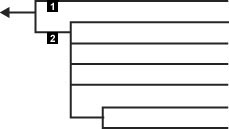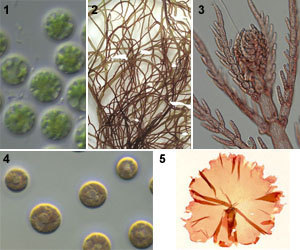| NIES-MCC | KU-MACC | Tree to Strain | Japanese | English |
| Life / Eukarya / Plantae / Rhodophyta | |

|
Cyanidiophyceae (Cyanidioschyzon, Cyanidium etc.) Porphyridiophyceae (Porphyridium etc.) Compsopogonophyceae (Compsopogon, Erythrocladia, Rhodochaete etc.) Stylonematophyceae (Stylonema, Chroodactylon etc.) Rhodellophyceae (Rhodella etc.) Bangiophyceae (Porphyra, Bangia etc.) Florideophyceae (Gracilaria, Gelidium etc.) |
|
1. Cyanidiophytina 2. Rhodophytina |
|
| References |
|
|
The red algae (Rhodophyta) are mostly multicellular macrophytes but unicellular or microscopic filamentous speceies are also known (Figs 1, 4). Although some species inhabit in freshwater, hot spring or on soil, most red algae are coastal seaweeds. Red algae are basically autotrophic, but there are many parasitic species whose host is closely related autotrophic species. Some red algae, such as Porphyra (Bangiophyceae), Palmaria and Gelidium (Florideophyceae) are economically important to produce agar, carrageenans and foods. Nuclear, chloroplastid and mitochondrial genome sequences of Cyanidioschyzon merolae (Cyanidiophyceae) are reported (Matsuzaki et al. 2004, Nature 428: 653-657). Chemical compositions of cell wall are variable (cellulose, β-1,3-xylan, β-1,4-mannan etc.) and some species deposit calcium carbonate on cell wall. Red algae possess chloroplast surrounded by two membranes via primary endosymbiosis. Main photosynthetic pigment is (chlorophyll a and) phycobiliproteins that form the phycobilisome located on thylakoid. Red algae are usually reddish in color as their name, but sometimes violet, green and blue-green due to the quality and quantity of phycobiliproteins (Fig. 1). Strage polysaccharide is floridean starch deposited in cytoplasmic matrix. One of the most unique feature of red algae is the absense of flagellum and centriole through life cycle. Most multicellular species have unique connecting structure between cells, pit connection. Asexual reproduction by binary fission, sporogenesis or fragmentation. Red algae conducting sexual reproduction usually show alternation of gametophytes and sporophytes. |
 1: Porphyridium (Porphyridiophyceae, NIES-1034). 2: Hypnea(Florideophyceae, Hok-50). 3: Antithamnion(Florideophyceae, KU-1001). 4: Rhodella(Rhodellophyceae, NIES-1037). 5: Porphyra(Bangiophyceae). |